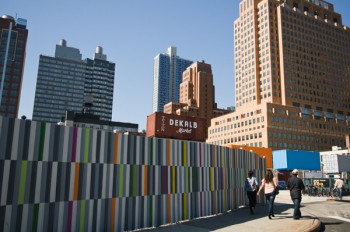Precisely! We love this write up by the NY Times (especially the part about us!). It brings to light what Dekalb Market is all about. Bringing together the best makers, artists, farmers, and chefs to one place and creating a destination for locals, tourists, and wondering brooklynites to put their feet up and relax (and shop and eat!)
AN urban farmoff the East River. Artisanal food and crafts sold out of recycled shipping containers at the Dekalb Market. Smorgasburg and the Brooklyn Flea on the Williamsburg waterfront.They all share a hipper-than-thou aesthetic. They also share a pedigree: they were all set up to breathe some life into vacant lots.
In an unlikely convergence of interests, it is the real estate executives who have invited the vendors to set up shop on their stalled construction sites. The owners, after all, get what they want: foot traffic to their neighborhood, which they hope will translate into good business or quicker apartment sales when they finally put a building up on the lot. And the vendors get cheap, sometimes free, space.
Many of these popular spots are remaining open through the winter or are planning to return in the spring and summer. Other undeveloped lots have also been optioned for interim duty as a food-truck lot and a kind of time-share backyard; some will even play host to various art exhibits.
These are happy solutions to an economic problem. The sluggish market has effectively turned off the spigot for construction financing, so there are more than 600 stalled construction sites in New York City, according to a recent count by the city.
For some developers, providing passers-by something other than a construction fence to look at is reason enough to find a temporary tenant.
The Dekalb Market, a |with its painted cargo containers, is hard to miss from Flatbush Avenue Extension in Downtown Brooklyn. Run by Urban Space, which also operates the holiday markets in Union Square and Columbus Circle, the market sits on the western edge of City Point, a huge project that will open its first 50,000 square feet of retail space sometime next year and plans to keep growing into 2020.
“The market brings life to the site,” said Tom Montvel-Cohen, a spokesman for City Point. “Now, when 50,000 people drive by every day, they see something interesting there — it’s a lot better than a ‘coming soon’ sign.”
A sign outside Riverpark Farm, at the eastern end of 29th Street, informs passers-by that it is on the future site of the second tower at the Alexandria Center for Life Science, “where construction was temporarily suspended due to the unprecedented worldwide financial crisis of recent years.”
The farm, which provides most of the produce for Tom Colicchio’s restaurant Riverpark, has put its 6,000 plants under plastic tents to survive the winter. Warm-weather plants like okra and tomatoes have been replaced with hardier ones like carrots. The plants are grown in stacked milk crates, which will be moved elsewhere on Alexandria’s campus when construction finally begins, but there are no plans to move them anytime soon.
Joel Marcus, chairman of Alexandria Real Estate Equities, says that although his company has the wherewithal to self-finance its next building, “there are a lot of economic storm clouds around right now, and we’re not going to be foolish about how we deploy capital.”
In addition to giving diners at Riverpark an unusual farm-to-table experience, Mr. Marcus said the farm, a field of green before the tents went up, had been “a big attraction for our other tenants as well.” It has been such a success, he added, that Alexandria plans to help create others on stalled sites it owns elsewhere, for instance in Massachusetts and North Carolina.
Other developers say interim uses have drawn crowds that have helped further define the neighborhoods around their development sites.
The Rockrose Development Corporation owns several lots and buildings in the Court Square area of Long Island City, Queens. In July, Rockrose agreed to let the New York City Food Truck Association use one of the parking lots as a food-truck lot, free of charge. A rotating schedule of trucks arrives each workday to cater to nearby office workers.
Then, in August, Rockrose offered a different lot to 3rd Ward, an arts group that hosted Dumpster pool parties every weekend and will do so again next summer. Rockrose also plans to let Chashama, an organization that has linked artists and performers with vacant locations since 1995, use several buildings for gallery and theater space.
“This takes the parcels there and causes some excitement, gets people out on the street,” said Patricia Dunphy, a senior vice president of Rockrose. “What we’re really doing is neighborhood building, and the young people that these kinds of things attract are going to be our target group.”
The Brooklyn Flea and Smorgasburg, the open-air shop and food markets that ran on weekends into November and drew as many as 15,000 people a day, may have helped sell apartments at the Edge, a two-building condo complex in Williamsburg with 564 apartments. The markets were on the waterfront lot that is to be the site of a third condo tower.
The developer, Douglaston Development, sold 98 apartments in 2010 but has sold more than 250 this year, bringing the building to 80 percent sold. “Success has a thousand fathers,” said Jeffrey E. Levine, chairman of Douglaston Development, adding that there was no question the markets were “a boon to sales and a boon to foot traffic.”
The sales office was so busy on weekends when the markets were still running, sometimes handling as many as 75 visitors a day, that the development stopped giving tours of its amenity space to avoid annoying residents trying to lounge peacefully by the pool or use the gym.
Mr. Levine said the rent the Brooklyn Flea paid to run the two markets had barely covered costs for security and cleanup. “But this was not a money-making effort,” he said. “It always was a marketing focus.”
Jonathan Butler, a founder of the Brooklyn Flea, said he had been looking for a Williamsburg site for some time to complement the Flea’s first site in Fort Greene. “For us it was a no-brainer to go over there,” he said. “And they were smart enough to recognize it would be a big win for them, too.” Smorgasburg is set to return to Williamsburg on April 7, the Flea on April 8.
“The operators of the Flea are hoping we never build another building,” Mr. Levine said. “You tell me when commercial banking comes back, and I’ll tell you when we’ll begin the next tower.”
http://www.nytimes.com/2011/12/25/realestate/temporary-tenants-bring-life-to-stalled-construction-sites.html?_r=2&scp=1&sq=%22dekalb%20market%22&st=cse




















































